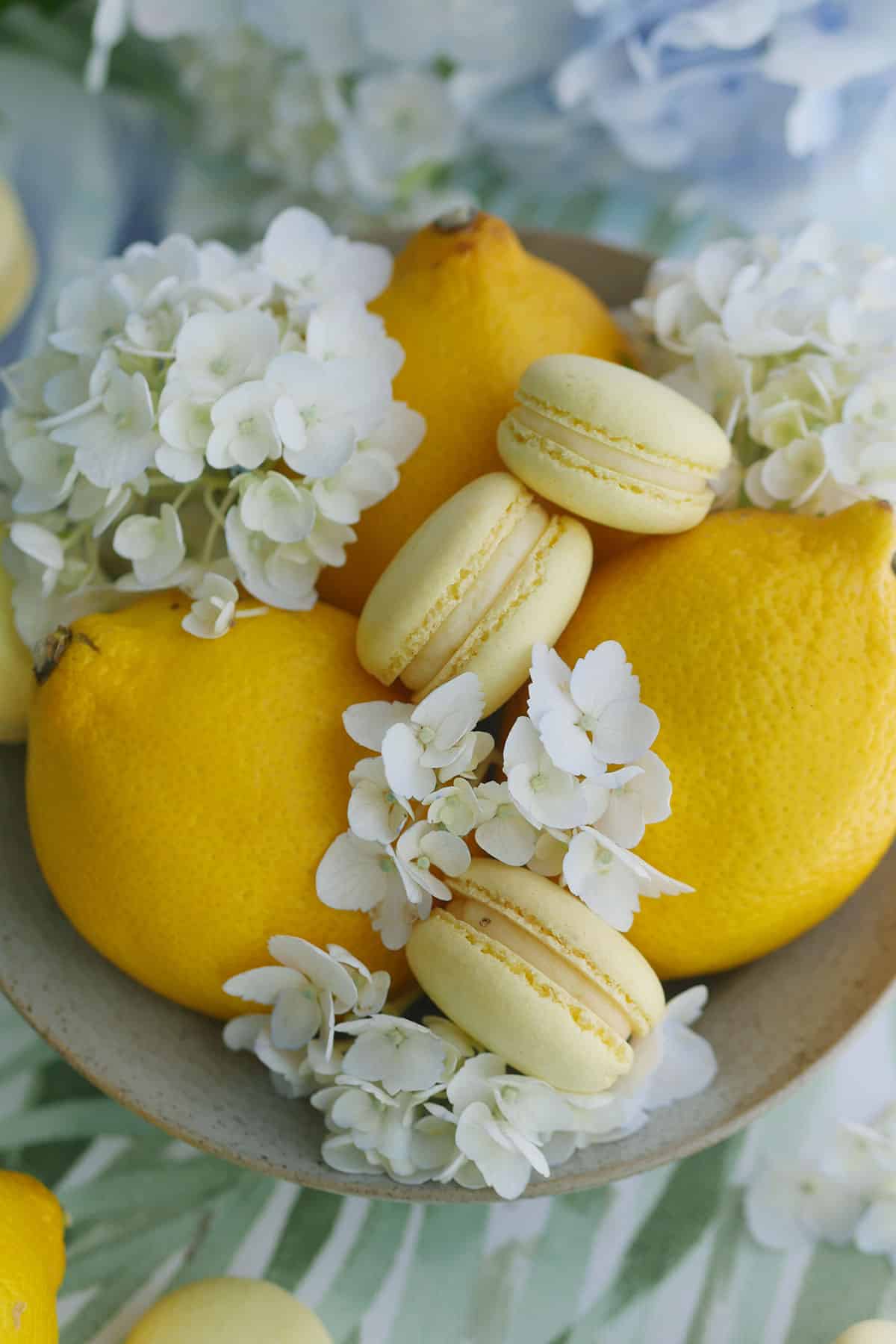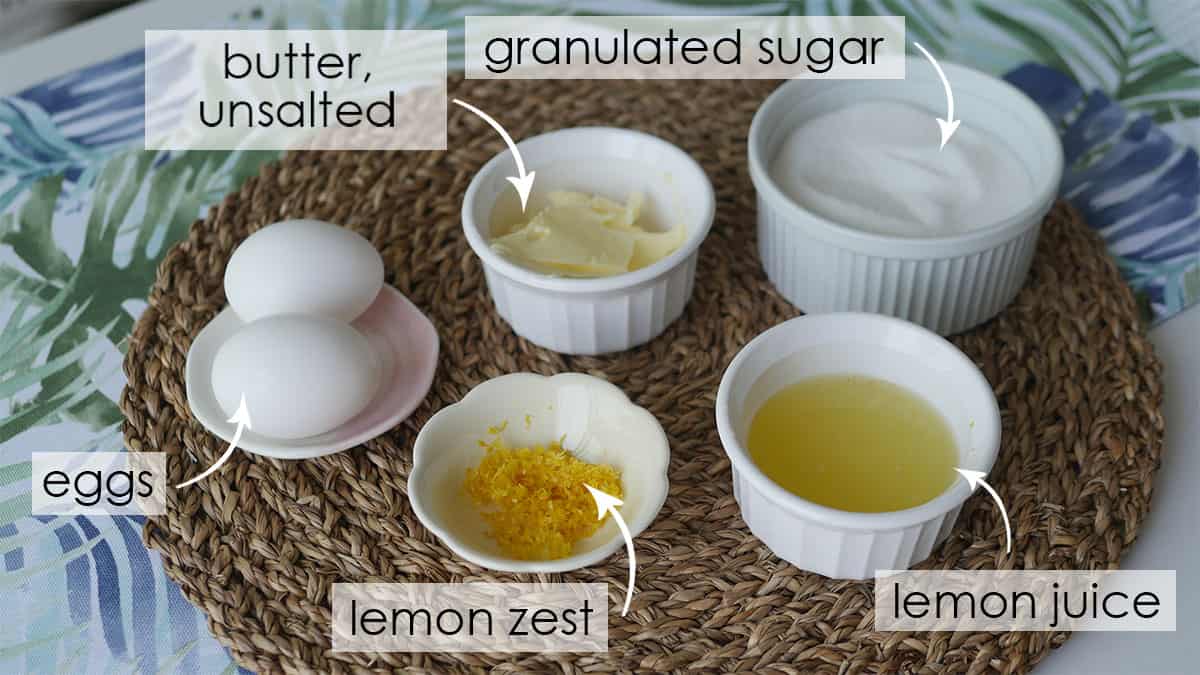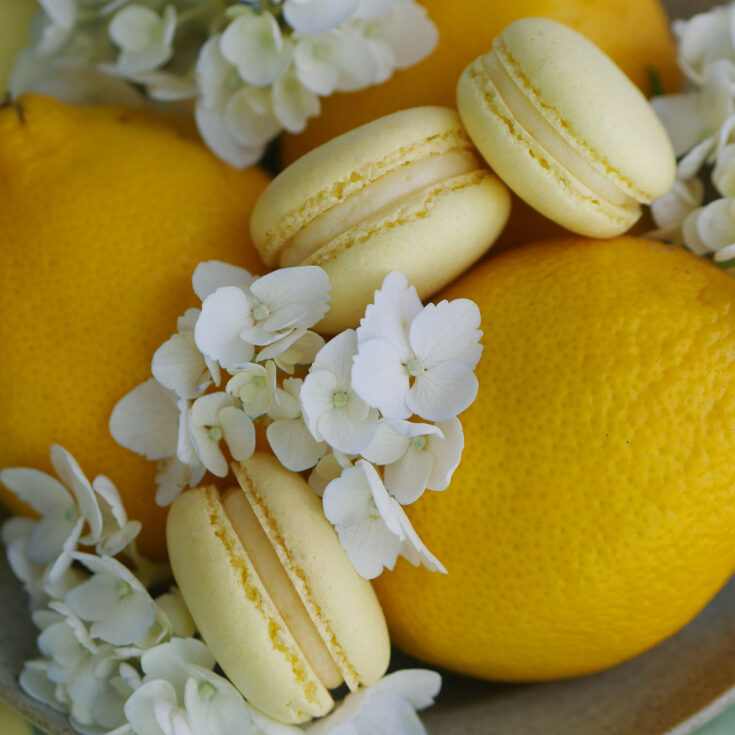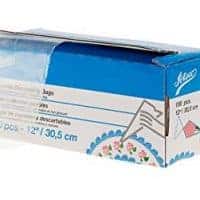Macarons filled with a lemon cream and curd that won't make macarons soggy. It's a mouthwatering and delicious macaron recipe made with REAL lemons - no artificial flavours.

Jump to:
Why You'll Love This Recipe
- Low-moisture lemon curd prevents macarons from getting soggy.
- Uses all natural ingredients, no artificial flavors.
- Uses simple ingredients that can be found at most grocery stores.
- Mouthwatering and delicious. Cuts down the sweetness of the macaron shells.
How To Prevent Soggy Lemon Curd Macarons
I don't know about you, but I found that every macaron filled with lemon curd I've had in the past has been soggy since fruit curds are higher in moisture than other fillings. So in this recipe, I created a lemon curd recipe that would not cause the macaron shells to become soggy. The curd itself is low in moisture so it won't start eating away at the macarons shells (get my Best Macaron Recipe here). A lemon curd is made first and then added into a Swiss meringue buttercream to create a lemon buttercream. The buttercream is piped into a ring shape, creating a dam, which will then be filled with the low-moisture lemon curd. The end result is a very sturdy and lemon-y curd that holds up inside the macaron for days. I'm so pleased with the results and I hope you will get a chance to test out this new recipe. It's perfect for those who are looking for a macaron that is "less sweet".

How To Make Macarons Less Sweet?
One of the most common complaints about macarons is that they are "too sweet", I am from the camp that you should take macarons as they are. Either you like them or you don't and forgo manipulating the sugar level in the shells to make it less sweet. Sugar is one of the few but basic ingredients in the shells and you need a certain amount of it for it to be stable. There are still ways to get around the perception of it's sweetness and one of them is to consider the fillings that it's being paired with.
The type and flavour of the fillings can greatly impact how sweet the resulting macarons will be. An American Buttercream - one that is made with icing sugar and butter - will be considerably sweeter than the Swiss or Italian version. Learn more about different Macaron Filling Types here. My personal preference is to never use an American buttercream with macarons. It may be a sweet indulgence on cupcakes but it's sugary taste can be too much when paired with an already sweet macaron shell.

Tart Lemon Filling Cuts the Sweetness in Macarons
Another quick remedy to reduce the sweetness in macarons is to fill it with a tart fruit filling. The acidity in fruit fillings is a perfect mouthwatering contrast to the sweet shells. One of my favourite fruit fillings is the lemon buttercream with a lemon curd center. I really appreciate how this flavour can be achieved entirely with the fruit itself without the need for artificial flavourings.


Ingredients and Substitutions
For the Lemon Curd and Buttercream
- Organic Lemons - This recipe requires using the zest of the lemons so organic lemons will be preferable.
- Eggs - large size.
- Butter - Use unsalted. For use in the buttercream, ensure that the butter is at room temperature. This is crucial for it to incorporate into the meringue mixture.
- Granulated sugar
For the Basic Macaron Shell
- Almond flour - it should be ground from blanched almonds. Some brands are more "oilier" than others so for the most consistent results, I like to make my own homemade almond flour. Alternatively, many readers have had good results with this brand.
- Powdered sugar - this is also known as icing sugar or confectioner's sugar. The type sold in North America usually contains a bit of corn starch as an anti-coagulant.
- Castor sugar - this is also known as extra fine granulated sugar or berry sugar. It's a finer granulated sugar that dissolves readily into the meringue making it ideal for macarons, which is heavily dependent on a strong and healthy meringue. If you can't find castor sugar, just use regular granulated sugar. Do not try to pulverize regular granulated sugar in the food processor to make castor sugar, it results in "chopped-up sugar crystals that will not perform well." (Source: chsugar.com)
- Egg whites, aged - egg whites that have been separated and let to "age" in the fridge have more relaxed proteins which makes it easier to whip to volume without overwhipping. It's recommended for the beginner macaron baker but is not absolutely necessary. Most carton egg whites are not intended for whipping into a meringue, check the back of the carton. A few (but not many) readers have reported success with carton egg whites.
- Cream of tartar - is an acid that is added to the meringue to make it more stable. It is usually found in the baking aisle next to the spices. If you do not have cream of tartar, you can substitute it with another acid like lemon or vinegar in double the amount. You can skip this ingredient if you can't find it. Make sure your bowls are clean and dry and whip carefully with room temperature aged egg whites until it reaches still peaks. If your egg whites take too long to whip or breaks apart, reconsider using cream of tartar.
- Gel food color - this is a more potent form of food color that doesn't add unwanted moisture into the macaron batter. Some brands perform better than others, I prefer this brand for its color stability, it doesn't fade after baking.
Tips for Success
- Have a cooking thermometer ready to measure the temperature of the lemon curd and swiss meringue buttercream. Heating the ingredients to the correct temperature is crucial. If you don't have a thermometer, you can check the readiness of the curd by running a spoon through it. If it coats the back of the spoon, it's ready. For the Swiss meringue, feel the mixture to see if all the sugar granules have dissolved.
- Use non-reactive tools and bowls as they can react to the acidity in the lemon juice, imparting a metallic taste. Non-reactive materials include: silicone, glass, ceramic and rust-free stainless steel.
- During the the heated bath step when making the curd and Swiss buttercream, avoid placing the mixture bowl on the hot water directly as it will cook the ingredients too quickly or over-cook it. Use a smaller pot of hot water and let a larger bowl hang over the top without touching the water. Make sure to move the mixture around gently to keep it moving and not over cook.
- This lemon macaron filling requires a Swiss buttercream as a base. If you need a more detailed instructions in that area, please read this dedicated post on: Swiss Meringue Buttercream.
How to Make
To make the lemon curd: Zest the organic lemon, set aside. Cream butter and sugar together until incorporated.

Add egg and beat until incorporated. If not already using, move mixture into a heatproof glass bowl, add lemon juice and beat until incorporated. (Some metal bowls can react to the acidity in the lemon juice.)

Place over a pot of boiling water. Do not let the bottom touch the water. Whisk gently to keep the mixture moving as it heats up. Occasionally, check the temperature of the mixture. You should see the curd thicken up and it will coat the back of your spoon. Allow the mixture to reach 180F-185F. It might take a while (10-15 min), so be patient.

Take the mixture off the heat, add the lemon zest into the hot mixture to release the oils and mix until combined. Pour through a sieve into another bowl for a smooth curd. Let it cool down then place in the fridge. It will set up into an even firmer and thicker curd after you've chilled it in the fridge.

To make lemon buttercream: Bring a small pot of water to a boil. Place egg whites and sugar into a heat proof bowl. Stainless steel is light and safe. Whisk the whites & sugar mix over the boiling water. Pay attention to whisking the mixture when it starts getting hot, you don’t want to cook the eggs.
Whisk the mixture until the temperature reaches 160F. Pour the mixture into the Kitchenaid mixer and whisk on low with the balloon whisk, then turn it up to medium.
Once the mixture is stiff and the bottom of the bowl is cool to the touch, stop mixer. Change the whisk attachment to the paddle attachment.

Add butter a little bit at a time while beating with the paddle attachment at medium speed.
The mixture might look curdled or separated for a while but keep mixing. It will all come together. Keep 200 grams of the buttercream for use in our current recipe. Freeze the rest of the buttercream for use at a later date.

Add 8 tablespoon of the curd into the buttercream, a tablespoon at a time and beat until incorporated. To Assemble: pair two similar sized shells together. Pipe a ring of lemon buttercream as a dam then fill it with the lemon curd. Assemble with other shell. Place in an airtight container in the fridge and give it 12-24 hours to mature before eating. Enjoy!


Recipe
Lemon Macarons with a Sturdy Low-Moisture Lemon Curd Filling

Ingredients
Macaron-Perfect Lemon Curd
- zest of two organic lemons (Note 1)
- 76 grams organic lemon juice
- 2 eggs
- 50 grams butter, unsalted
- 180 grams granulated sugar
Lemon Buttercream
- 65 grams egg whites
- 130 grams granulated sugar
- 195 grams butter, unsalted at room temperature
Basic Macaron Shell
- 240 grams almond flour
- 240 grams powdered sugar
- 185 grams egg whites, aged, room temperature
- 165 grams castor sugar (Note 2)
- ½ tsp. cream of tartar
- Gel food color (Note 3)
Instructions
Macaron-Perfect Lemon Curd
- Zest the organic lemon, set aside.
- Cream butter and sugar together until incorporated.
- Add egg and beat until incorporated.
- If not already using, move mixture into a heatproof glass bowl, add lemon juice and beat until incorporated. (Some metal bowls can react to the acidity in the lemon juice.)
- Place over a pot of boiling water. Do not let the bottom touch the water.
- Whisk gently to keep the mixture moving as it heats up.
- Occasionally, check the temperature of the mixture. You should see the curd thicken up and it will coat the back of your spoon. Allow the mixture to reach 180F-185F. It might take a while (10-15 min), so be patient.
- Take the mixture off the heat, add the lemon zest into the hot mixture to release the oils and mix until combined.
- Pour through a sieve into another bowl for a smooth curd.
- Let it cool down then place in the fridge. It will set up into an even firmer and thicker curd after you've chilled it in the fridge.
Lemon Buttercream
- Bring a small pot of water to a boil.
- Place egg whites and sugar into a heat proof bowl. Stainless steel is light and safe.
- Whisk the whites & sugar mix over the boiling water.
- Pay attention to whisking the mixture when it starts getting hot, you don’t want to cook the eggs.
- Whisk the mixture until the temperature reaches 160F. This temperature is generally accepted to be able to kill salmonella in eggs.
- Pour the mixture into the Kitchenaid mixer and whisk on low with the balloon whisk, then turn it up to medium.
- Once the mixture is stiff and the bottom of the bowl is cool to the touch, stop mixer. Change the whisk attachment to the paddle attachment.
- Add butter a little bit at a time while beating with the paddle attachment at medium speed.
- The mixture might look curdled or separated for a while but keep mixing. It will all come together.
- Keep 200 grams of the buttercream for use in our current recipe. Freeze the rest of the buttercream for use at a later date.
- Add 8 tablespoon of the curd into the buttercream, a tablespoon at a time and beat until incorporated.
Basic Macaron Shell
- Set aged egg whites out at room temperature.
- Pulse almond flour and powdered sugar together in a food processor to further break down any large pieces of almond flour.
- Sift dry ingredients: almond flour, icing sugar. Discard big pieces of almond that can't be sifted.
- If you are new to macaron baking, please read the instructions to my BEST MACARON RECIPE before attempting to follow the rest of the instructions since it is condensed for the advanced macaron baker.
- With the balloon whisk attached, whip the room temperature egg whites on low-medium speed.
- Add cream of tartar when it becomes foamy.
- Turn up the speed to medium.
- Once the whisk starts to leave tracks in the egg whites, add sugar a little at a time.
- Turn the speed up to medium-high and whip until firm peaks, stop mixer and add gel food color if desired. Continue whipping on medium-high until stiff peaks.
- Fold the dry mix and meringue together until the batter becomes a "lava" or honey-like consistency.
- Transfer batter into a piping bag fitted with a round piping tip.
- On parchment paper or silicone mats, pipe out round shaped macarons.
- Rap the tray hard on the counter to remove any excess air bubbles. Use a toothpick to pop any remaining bubbles.
- Wait until the shells become completely dry before baking.
- Bake at 325F for 12-14 minutes. Every oven is different, you may need to adjust your own temperature settings. Please read How to Use Your Home Oven Properly for Baking Macarons if you are unsure.
- Macarons are done when the foot doesn't push back and the tops don't move when you wiggle it.
- Once baked, let cool completely before removing from the baking mat/parchment paper.
Assembly
- Pair two similar sized shells together.
- Pipe a ring of lemon buttercream as a dam then fill it with the lemon curd. Assemble with other shell.
- Place in an airtight container in the fridge and give it 12-24 hours to mature before eating. Enjoy!
Notes
- Organic lemon was used in this recipe since it requires the zest. Most of the pesticides on citrus fruits can be found on the peel.
- Castor sugar is also known as extra fine granulated sugar or berry sugar. Granulated sugar can be used by castor sugar is preferable.
- Americolor Lemon Yellow was used here.
Recommended Products
As an Amazon Associate and member of other affiliate programs, I earn from qualifying purchases.
-
 Ateco Disposable Piping Bags, 12-Inch, Pack of 100
Ateco Disposable Piping Bags, 12-Inch, Pack of 100 -
 India Tree Superfine Caster Baking Sugar, 1 lb. bag
India Tree Superfine Caster Baking Sugar, 1 lb. bag -
 Gel Food Coloring AmeriColor Junior Kit, 8 Colors.75 Ounce Bottles
Gel Food Coloring AmeriColor Junior Kit, 8 Colors.75 Ounce Bottles -
 Regular Sized Silpat Non-Stick Silicone Baking Mat
Regular Sized Silpat Non-Stick Silicone Baking Mat -
 Bob's Red Mill Super-Fine Gluten Free Almond Flour, 3 Pound
Bob's Red Mill Super-Fine Gluten Free Almond Flour, 3 Pound -
 Anthony's Almond Flour Blanched, 2lb, Batch Tested Gluten Free, Non GMO, Vegan, Keto Friendly
Anthony's Almond Flour Blanched, 2lb, Batch Tested Gluten Free, Non GMO, Vegan, Keto Friendly
Nutrition Information
Yield
45Serving Size
1 gramsAmount Per Serving Calories 71Total Fat 5gSaturated Fat 3gTrans Fat 0gUnsaturated Fat 1gCholesterol 20mgSodium 41mgCarbohydrates 7gFiber 0gSugar 7gProtein 1g
This information is provided as a courtesy and is an estimate only. This information comes from online calculators. Although indulgewithmimi.com attempts to provide accurate nutritional information, these figures are only estimates.





Emily Burger says
I want to make a thick mango curd do you have any advice? Can I just sub out the lemon juice for mango puree?
Mimi says
Hi Emily,
I haven't tried using mango as a substitute but I believe you might run into some problems with it solidifying the same way as the ph of mangos is higher than lemons. Also the flavor of mangos is pretty mild. For the flavor to come through without having to add too much of the fruit juice, lemon and other tart fruits work better.
XOXO,
Mimi
SallyBR says
Hi, Mimi!
made the curd today, will make macs and buttercream tomorrow... I wanted to tell you I cooked the curd in the microwave, worked like a charm - about 4 minutes and a half at 80% power in my microwave is all it takes - with a little stirring maybe 3 times during those minutes.
Really looking forward to these tomorrow!!!!!
Mimi says
I'm so happy to hear your feedback. Thanks for coming back to let me know how it worked for you, I'm sure this comment will be very useful for my readers. I like that you used lowered power and constant stirring to prevent the eggs from overcooking. Microwaving egg products can be tricky as there are hot spots created during the process. I'm glad it worked for you. I hope you enjoyed them for 4th of July, I assume 🙂
XOXO,
Mimi
SallyBR says
worked like a charm - I stored some in the freezer some at room temp - no problem with the shells at all
I have been using the microwave for curds for a few years, as long as it is not full power and once i figured out the timing for our machine it is quite reproducible and gives a very smooth curd.
Thank you so much - I will blog about it and link to your post!
Mimi says
Yes, I do agree, learning how to use the lower power settings in the microwave can really help with different dishes.
Sounds great! I can't wait to read it! Thanks for your reply!
Xoxo,
Mimi
Rey says
Thanks for the macaron friendly curd recipe! Can I use this same recipe to make an orange curd that’s macaron safe?
Mimi says
I haven't tried using the proportions in this recipe to make orange curd instead so I can't give you any info based on experience. However, oranges are less acidic and may affect the thickening process and how thick your curd turns out.
XOXO,
Mimi
Celia says
Can I use plain flour I stead? Some websites say I can but texture will be different and some say I can't.
Mimi says
Hi Celia,
Do you mean for the macarons? I haven't tried with regular flour so I can't weigh in on that. Maybe you can look up a recipe that does contain flour and see the reviews on it?
XOXO, Mimi